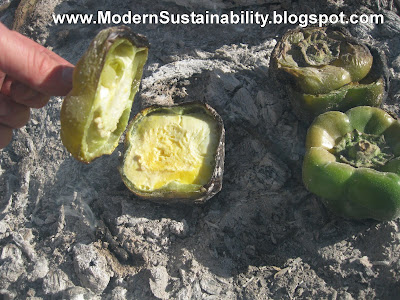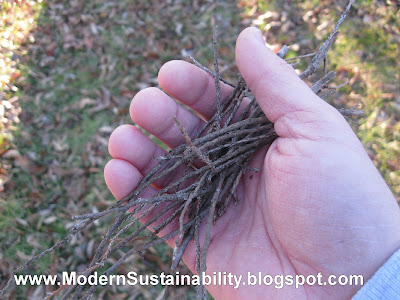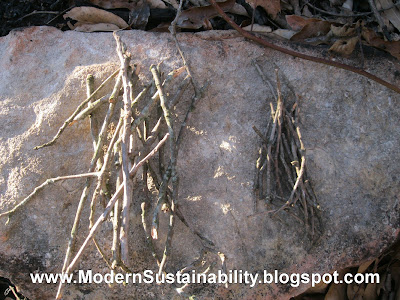This is my first post in a new section of this blog that I am calling "Boy Scout Skills". Being a Boy Scout has been one of the best experiences in my life and has taught me how to plan meals and activities, survive through tough challenges and learn old-fashioned skills. A lot of my posts seemingly have very little to do with Modern Sustainability, however primitive cooking is skill that brings us closer to our origins. Anything that slows us down and teaches us old fashioned skills not only makes us think about things differently, but makes us more capable as people. I hope the new section on Boy Scout Skills will teach you some good camping skills, but also make you feel closer to your roots and feel more capable. Future topics will include; how to build a 1 match fire, how to build a reflector oven, how to camp comfortably in winter and primitive shelter building among other things.
I also hope this post may inspire some Scout Troops to do a primitive camp out or get back to old-fashioned scouting. Too many Troops these days camp out of pick-up trucks at camp grounds instead of hiking into primitive campsites. Patrol Dads tell the kids what to do instead of the older kids teaching the younger kids, learning leadership skills in the process. Or worse, the Dads cook over their Coleman stoves and the kids learn nothing about cooking. Scouting has embraced our high tech world allowing the boys to camp with cell phones and GPS units instead of learning to navigate by map and compass. A Scout will only learn how to plan when he has to carry his pack for a mile or two before choosing a camp site. You learn quickly what to bring and what not to bring if you have to carry a 50 lb. pack 3 miles. Kids learn how to patiently cook and clean their cooking gear when they have to function as a patrol. When the patrol Dad is giving out the orders they learn nothing about cooperation and team work. Boys learn that when you take care of your gear, your gear takes care of you when you camp in the rain or snow and you are warm and dry because you packed your sleeping bag and clothes in waterproof stuff bags. I could go on and on, but lets talk about primitive cooking.
You will hopefully never have to cook primitively, but it is fun and it makes you feel proud to know you can. Kids love it.

Here is pretty big fire with eggs cooked inside green peppers, bacon on a stick and cinnamon bread cooked inside a hollow orange peel. This is a typical breakfast on a primitive campout. First you build a big fire to create coals that you can pull aside in a flat area to set your peppers and oranges on. Fill them with eggs and bread prior to placing them in the coals. I cannot emphasize patience enough, especially when kids are involved. When people lose patience, food either gets burnt or gets spilled. Keep small fires going around the peppers and oranges by adding small (pencil size) sticks carefully around them without knocking them over. They will take at least 30 minutes to cook.

Here is a nice spit we built for cooking chickens. All wood that is close to the fire must be green wood (newly cut from a living tree) or else it will burn up. The tripod supports give the spit stability as the chickens may take several hours to cook.

Place the chickens on a long green stick that is intentionally rough because you want to be able to rotate the stick without the chickens spinning around only cooking one side. We use natural twine to tie the bird to the spit to keep the legs and wings from cooking too fast. The twine is also used to lash the spit together. This is a pretty advanced meal to cook over a fire, but nothing tastes better over a fire than a well-cooked chicken. Usually to accompany the chicken we will prepare indian ash bread and mud potatoes. The indian ash bread is just the dough from about 3 biscuits that are rolled into a ball and cooked in the coals. Rotate them in the coals and the outside will be dirty and burnt, but the inside is very tasty. They only take about 20 minutes to cook, so put them on last. The mud potatoes are really fun. You take large potatoes and pack them in mud. About 1" of mud all around the potato. Carefully place the mud packed potatoes into the coals and build a small fire above them so they are heated on all sides. In about 1 hour the mud will crack off and you have a perfectly cooked potato. The skin peels off cleanly and the white inside is perfectly clean and tasty. Everything tastes better over a fire, but I can eat these potatoes without butter or salt.

Bacon on a stick is a real treat for breakfast. It is easy and fun for the kids.

Eggs and cinnamon bread slowly cooking in the coals. When cooking over a fire it is almost like you have several different fires in one. You must keep flames going under the bacon or chicken and the coals cooking the bread, potatoes or eggs need to be away from the flames so that they are not disturbed when the wood is added below the meat. It takes practice to do this well.

We had better luck with the eggs cooked in a pepper with a lid on. We put two eggs in each large pepper.

A close up of the cinnamon bread cooked inside an orange. Of course we ate the orange as an appetizer before using the peel as a bowl to cook inside. Take care not to break the peel apart.

Indian ash bread and mud potatoes on our primitive table we lashed together. For the primitive campout we are not allowed to bring electrical devices so we use candles and the campfire for visibility. We also have to build our own shelters for the primitive campout, but that is a future post. Have fun.
 The trick is to start with small (tooth pick size or smaller) dry wood. This is critical. If you try to start with large twigs, the match will burn out before the wood catched fire. If it does not snap, it is not dry enough. In Missouri and over much of the United States, Eastern Red Cedar is a great source of dry small kindling, but in other parts of the country other trees (Pine) will work. You just have to do a little experimenting to see what works best for you. Even in a down pour you can find dry dead interior twigs that are dry enough to start a fire with.
The trick is to start with small (tooth pick size or smaller) dry wood. This is critical. If you try to start with large twigs, the match will burn out before the wood catched fire. If it does not snap, it is not dry enough. In Missouri and over much of the United States, Eastern Red Cedar is a great source of dry small kindling, but in other parts of the country other trees (Pine) will work. You just have to do a little experimenting to see what works best for you. Even in a down pour you can find dry dead interior twigs that are dry enough to start a fire with. Air movement it critical. Place your small kindling up off the ground so that you can easily place a lit match under the kindling. Here I have used 2 larger branches to support the kindling. Note the size of the kindling in relation to the match. If it is windy, use your body to block the wind from blowing out the match.
Air movement it critical. Place your small kindling up off the ground so that you can easily place a lit match under the kindling. Here I have used 2 larger branches to support the kindling. Note the size of the kindling in relation to the match. If it is windy, use your body to block the wind from blowing out the match. You will want to have the next sizes of wood ready to go (already gathered, broken and next to the fire site) before you start the fire. The kindling will burn out fast so if you have to run around looking for more wood, your fire will be out when you return.
You will want to have the next sizes of wood ready to go (already gathered, broken and next to the fire site) before you start the fire. The kindling will burn out fast so if you have to run around looking for more wood, your fire will be out when you return. Hold the match horizontal so that it does not go out and so that it does not burn too fast. Fire burns up so if you hold it vertically it will burn out before the kindling is burning.
Hold the match horizontal so that it does not go out and so that it does not burn too fast. Fire burns up so if you hold it vertically it will burn out before the kindling is burning. Once the fire is going, gently add more small kindling until you have a fire that you feel comfortable the wind will not blow out or the wood will not burn out if you walk away. Do not add large wood too quickly. Teach kids to place the kindling on the fire, not throw it, as that will disturb the fragile small fire.
Once the fire is going, gently add more small kindling until you have a fire that you feel comfortable the wind will not blow out or the wood will not burn out if you walk away. Do not add large wood too quickly. Teach kids to place the kindling on the fire, not throw it, as that will disturb the fragile small fire.







